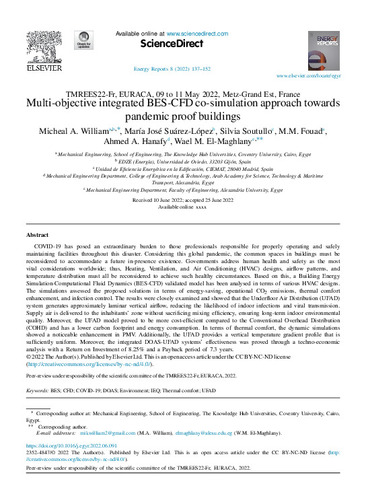Multi-objective integrated BES-CFD co-simulation approach towards pandemic proof buildings
Autor(es) y otros:
Palabra(s) clave:
BES
CFD
COVID-19
DOAS
Environment
IEQ
Thermal comfort
UFAD
Fecha de publicación:
Versión del editor:
Citación:
Descripción física:
Resumen:
COVID-19 has posed an extraordinary burden to those professionals responsible for properly operating and safely maintaining facilities throughout this disaster. Considering this global pandemic, the common spaces in buildings must be reconsidered to accommodate a future in-presence existence. Governments address human health and safety as the most vital considerations worldwide; thus, Heating, Ventilation, and Air Conditioning (HVAC) designs, airflow patterns, and temperature distribution must all be reconsidered to achieve such healthy circumstances. Based on this, a Building Energy Simulation-Computational Fluid Dynamics (BES-CFD) validated model has been analysed in terms of various HVAC designs. The simulations assessed the proposed solutions in terms of energy-saving, operational CO2 emissions, thermal comfort enhancement, and infection control. The results were closely examined and showed that the Underfloor Air Distribution (UFAD) system generates approximately laminar vertical airflow, reducing the likelihood of indoor infections and viral transmission. Supply air is delivered to the inhabitants’ zone without sacrificing mixing efficiency, ensuring long-term indoor environmental quality. Moreover, the UFAD model proved to be more cost-efficient compared to the Conventional Overhead Distribution (COHD) and has a lower carbon footprint and energy consumption. In terms of thermal comfort, the dynamic simulations showed a noticeable enhancement in PMV. Additionally, the UFAD provides a vertical temperature gradient profile that is sufficiently uniform. Moreover, the integrated DOAS-UFAD systems’ effectiveness was proved through a techno-economic analysis with a Return on Investment of 8.25% and a Payback period of 7.3 years.
COVID-19 has posed an extraordinary burden to those professionals responsible for properly operating and safely maintaining facilities throughout this disaster. Considering this global pandemic, the common spaces in buildings must be reconsidered to accommodate a future in-presence existence. Governments address human health and safety as the most vital considerations worldwide; thus, Heating, Ventilation, and Air Conditioning (HVAC) designs, airflow patterns, and temperature distribution must all be reconsidered to achieve such healthy circumstances. Based on this, a Building Energy Simulation-Computational Fluid Dynamics (BES-CFD) validated model has been analysed in terms of various HVAC designs. The simulations assessed the proposed solutions in terms of energy-saving, operational CO2 emissions, thermal comfort enhancement, and infection control. The results were closely examined and showed that the Underfloor Air Distribution (UFAD) system generates approximately laminar vertical airflow, reducing the likelihood of indoor infections and viral transmission. Supply air is delivered to the inhabitants’ zone without sacrificing mixing efficiency, ensuring long-term indoor environmental quality. Moreover, the UFAD model proved to be more cost-efficient compared to the Conventional Overhead Distribution (COHD) and has a lower carbon footprint and energy consumption. In terms of thermal comfort, the dynamic simulations showed a noticeable enhancement in PMV. Additionally, the UFAD provides a vertical temperature gradient profile that is sufficiently uniform. Moreover, the integrated DOAS-UFAD systems’ effectiveness was proved through a techno-economic analysis with a Return on Investment of 8.25% and a Payback period of 7.3 years.
Ficheros en el ítem





